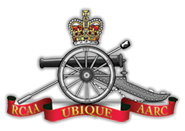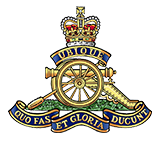The South African War 1899-1902
During the interval between the rebellion and the South African War The Regiment, under the tutelage of Major (later Major-General) C.W. Drury, became considerably more modernized. Drury, on a posting to Britain, had paid particular attention to new developments in fire discipline and technical improvements. As Commandant of the Deseronto Camp, he injected considerably more realism into training, and by stressing competitions, spurred the militia gunners on to greater efficiency. His contributions were to earn him the name of “Father of Modern Artillery in Canada.” The Regiment owes him a great deal. He brought it into the modern era and, in a real sense, gave it the groundwork of skills that it would require at the beginning of World War I. The period was one in which great strides were being made in the development of artillery. It was at this time that Canada acquired 12 Pdr breech-loading guns, which were available for range practice in 1897. These were the guns with which the Royal Canadian Field Artillery would serve in South Africa.
Shortly after the outbreak of the war between Great Britain and the Boer Republics of the Transvaal and the Orange Free State, public pressure led to the dispatch of two Canadian Contingents to South Africa. Many Gunners volunteered to serve in the infantry of the First Contingent and fought at Paardeberg. Three batteries of field artillery formed part of the Second Contingent. The three artillery batteries were designated C, D and E. They were concentrated at Kingston, Ottawa and Québec respectively. Each battery was formed from members of the Royal Canadian Field Artillery (permanent force) with the remaining personnel coming from militia units in the general area of each place of concentration. C Battery was enrolled at Kingston, Gananoque, Winnipeg, Hamilton, St Catharines and Toronto; D Battery at Guelph, Ottawa, London and Port Hope; and E Battery at Québec, Montréal, Granby, Woodstock N.B., Newcastle N.B. and Sydney N.S. In command of the Brigade was Lieutenant-Colonel C.W. Drury.
The South African War was frustrating in some respects for Canadian Gunners. The Canadian Brigade consisted of three batteries, each armed with six 12 Pdrs, but the nature of the war did not permit the grouping of the Brigade or even of the batteries for operations. Most operations were conducted by two-gun Sections supporting mobile columns.
The war did, however, teach some valuable lessons. The adoption of indirect fire techniques was spurred on by the battles in this war. Boer marksmanship has been cited as the motivating factor but, in fact, the widespread use of the rifle in any hands would have been enough to end the older tactic of galloping up and engaging the enemy over open sights. Indirect fire training was implemented in Canada following the war.
C Battery formed part of the Rhodesian Field Force and took part in the relief of Mafeking and then in operations in the western Transvaal. D and E Batteries originally formed part of Carnarvon Field Force and then assumed line of communications duties on the main railway line to Kimberly. Later E Battery formed part of the Gruiqualand column and suffered one killed and eight wounded in action at Faber’s Putt. E Battery had the heaviest battle casualties of all three batteries. Total Gunner casualties in the conflict were 13 men killed and 11 wounded in action.
D Battery joined Lord Roberts’ main army in operations in the east Transvaal. It was at Leliefontein that a historic and successful rear-guard action was fought by a handful of Royal Canadian Dragoons and the left section of D Battery (the Gunners under the command of Lieutenant (later Major-General) E.W.B. “Dinky” Morrison of the 2nd Ottawa Field Battery). They defended against an attack by some 200 mounted Boers who had charged to within 70 yards of their position. Three of the Dragoons were awarded the Victoria Cross for this action. Lieutenant Morrison was awarded the Distinguished Service Order (DSO). One of the guns involved is now displayed in the Canadian War Museum. The following is an excerpt from the “Supplementary Report, Organization, Equipment, Dispatch and Services of the Canadian Contingents during the War in South Africa 1899-1900” from OC D Battery, RCFA to CC Brigade Division RCFA, dated 9 March 1901:
“It was soon evident that the Boers had heavily reinforced since yesterday. Col Lessard with The Royal Regiment Canadian Dragoons and two Royal Canadian Guns, the latter under Lt Morrison, covered the rear, and I have no praise too high for the devoted gallantry they all showed in keeping the enemy off the convoy and infantry.”
“In a telegram congratulating Gen Smith-Dorrien on the success of his operations, Lord Roberts said: ‘Col Lessard with his Canadians had a difficult task in guarding the rear of your return march and deserves great credit as do all who were with him.’”
“Gen Smith-Dorrien subsequently recommended Lt Morrison for ‘some special mark of Her Majesty’s favour for the skill and coolness with which he worked and finally saved his guns’. He was duly awarded the Distinguished Service Order.”
“During the two day’s fighting the section expended 240 rounds ammunition.”
The service and traditions of C, D, and E Batteries are perpetuated by the RCHA batteries with the same designation. After the war, King Edward gave two banners to The Regiment in recognition of the distinguished service by Canadian Gunners.
The most significant aspect of The Royal Regiment’s first overseas service was the increased recognition which now came from the Canadian and Imperial governments, not only in the form of increased appropriations, but also in an awareness of the excellence achieved by The Regiment.


